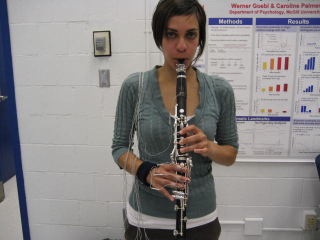


COVID-19 Application: The World Health Organization suggests that people hum a familiar tune, “Happy Birthday to you” as they wash their hands, so that the song lasts the right amount of time for the hand-washing to protect against infection. This example shows how music and other rhythms can guide important actions, such as how auditory warning signals tell us how quickly to cross the street.
The Sequence Production Lab at McGill University, headed by Dr. Caroline Palmer, investigates the behavioural and neural foundations (learning, memory, motor control, attention) that make it possible for people to produce auditory sequences, such as playing a musical instrument or speaking. Our research focuses on the cognitive and motor changes that occur as people coordinate their actions with others. We compare beginners, experts, and disordered populations, to determine how sensory feedback is linked to the movements that produce speech or music. How does the brain combine the "what" and "when" with the "how" to produce sound? Our research addresses these issues with several laboratory techniques.
Nous étudions les bases cognitives (apprentissage, mémoire, contrôle moteur, attention) qui permettent de produire des séquences auditives comme la parole et la musique. Notre recherche se concentre sur les changements cognitifs et moteurs qui surviennent lorsque les gens coordonnent leurs propres actions avec les autres. Nous comparons des débutants, des experts et des populations spéciales (pathologies) afin de déterminer comment les retroactions sensorielles sont associés aux mouvements produisant la parole et la musique. Comment le cerveau combine-t-il le "quoi" et "quand" avec le "comment" pour pouvoir produire du son?